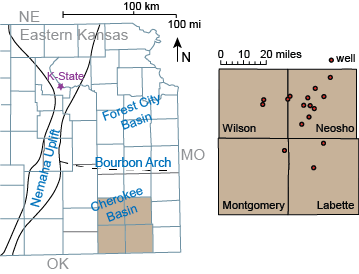Reports: UNI253188-UNI2: Field Study of Fundamental Controls on Methane Formation in a Coalbed Methane Reservoir
Matthew F. Kirk, PhD, Kansas State University
Our research group continued working to understand the two-way interactions between geochemistry and microbiology in coalbed methane reservoirs in the Cherokee Basin, Kansas, USA. Our efforts during project year 1 included sample collection (Fig. 1), laboratory geochemical and microbiological characterizations, and data analysis.
Figure 1. Location of 15 commercial coalbed methane wells we sampled for the study. At each well, we measured the pH, temperature, and electrical conductivity of water samples and we collected samples of water, gas, and microbes for laboratory analysis.
During year 2, we worked to integrate the results of our geochemical and microbiological analyses and prepare theses and a manuscript. This funding continues to provide a boost to my professional development and that of the students. Efforts in year 2 are as follows:
1. Data analysis
To understand links between geochemical and microbial factors controlling natural gas formation in the coalbeds, we used statistical calculations to search for significant relationships. Of the variables tested, our analysis indicates that formation water salinity is the most important factor that influences the composition of the archaeal community in the coalbeds.
2. Interpretation of results
We refined our interpretations during the past year. Our statistical analyses and isotopic analysis of water and gas shed light on a link between formation water salinity and the pathway of methane formation in the coalbeds. Methane was formed primarily by hydrogenotrophic methanogens. However, the proportion of methane formed by acetoclastic methanogens increases with the solute content of the water (TOC figure). This trend is unexpected because it is contrary to existing conceptual models for methanogenesis. It is significant because it helps us understand salinity constraints on methanogenic processes and how commercial gas production activities could influence natural gas formation.
3. Thesis and manuscript preparation
During the past year, the graduate student who was partially supported by the projected wrote and successfully defended a MS thesis. The undergraduate student who was supported by the project also completed an undergraduate thesis. He graduated with a BS in Geology and is now working toward his MS. We combined content from each thesis to draft a manuscript, which is currently in review.
4. Professional development
I have used my award to fund my first graduate and undergraduate students, established a working relationship with an energy industry partner, and collect a dataset that will provide a strong foundation for future energy research. The students involved have gained broad experience, which they have both successfully leveraged to get to the next steps in their career. The graduate student is now gainfully employed at a major energy company. The undergraduate student was successful in his application for an assistantship in graduate school. During the past year we have presented the research locally and at the annual meeting of the American Geophysical Union. In the coming year, we have additional presentation planned and will work to expand on some of the efforts initiated through this research award.












